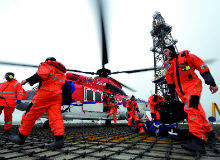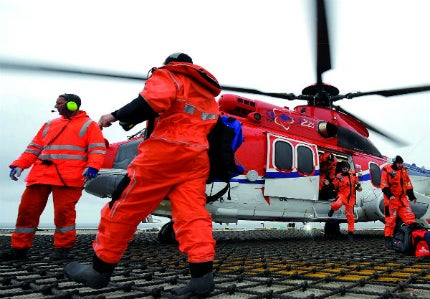

More than 62 million passengers flew to and from offshore installations in the British North Sea by helicopter between 1976 and 2012. In that time, there have been 72 accidents, 12 of them fatal.
With investment in offshore drilling predicted to grow by just more than eight percent on average per year up to 2020, aviation traffic is set to increase further, as multinationals and independent oil companies (IOCs) compete to extract diminishing hydrocarbon reserves from remote, deepwater locations and service decommissioning projects on the UK Continental Shelf (UKCS).
Minimising the risks of North Sea helicopter operations is clearly a priority, but despite efforts by regulators, operators and the offshore industry there have been five accidents in the last four years.
The Air Accidents Investigation Branch (AAIB) released an interim report last month into a crash near Sumburgh Airport off the coast of Shetland in August, in which four people died. In 2009, an accident involving the same model of helicopter – the AS332L2 Super Puma – claimed the lives of 14 offshore workers and two crewmen on a return flight to Aberdeen from BP‘s Miller oil field in the North Sea.
The issue of helicopter safety is by no means limited to the UKCS; there have been 15 fatalities as a result of accidents in the Gulf of Mexico in the past five years, and many more worldwide.
How well do you really know your competitors?
Access the most comprehensive Company Profiles on the market, powered by GlobalData. Save hours of research. Gain competitive edge.

Thank you!
Your download email will arrive shortly
Not ready to buy yet? Download a free sample
We are confident about the unique quality of our Company Profiles. However, we want you to make the most beneficial decision for your business, so we offer a free sample that you can download by submitting the below form
By GlobalDataJoint enterprise: the CAA helicopter safety review explained
The UK Civil Aviation Authority (CAA) has announced a forensic review of offshore helicopter operations in the North Sea, to be undertaken jointly with the Norwegian CAA and the European Aviation Safety Agency (EASA), and advised by a panel of independent experts.
"The recent accidents have understandably given rise to concerns, particularly with offshore workers who rely so heavily on these helicopter flights," said Mark Swan, director of the CAA’s Safety and Airspace Regulation Group. "The review will thoroughly examine the risks and hazards of operating in the North Sea and how these can be managed most effectively."
Encompassing current operations, previous incidents and accidents, as well as offshore helicopter flying in other countries, the review will focus on operator decision-making and internal management, the protection of passengers and crew, pilot training and performance and helicopter airworthiness.
Led by the CAA’s head of flight operations, Captain Bob Jones, in collaboration with Geir Hamre, head of helicopter safety for the Norwegian CAA, the two-stage project will include a baseline assessment of current safety performance levels, gap analysis of relevant materials to define best practice, a comparison study of UK operations with those in Norway and input from a team of industry stakeholders, including representatives from Statoil and the UK military.
The interim findings will be made available by the end of December 2013, before the final report is submitted to the CAA board with recommendations for improvements to the following areas: operational command and control; operator capabilities (including suitability of helidecks); protection of passengers and crew (including search and rescue procedures); training and pilot performance; airworthiness (in conjunction with EASA); and operational resilience.
United front: the Back Home Safe campaign and Step Change in Safety
The new initiative follows a comprehensive analysis of offshore helicopter reportable accidents from 1976-2012, in which the CAA established that the main causal factors were operational (pilot performance), technical (rotor and transmission failures) and environmental (lightning strikes).
The ongoing AAIB investigation into the fatal accident off the coast of Shetland on 23 August this year has failed to identify any technical fault, and will now focus on pilot monitoring of instruments and the training of crews. The AAIB investigators also called for a review of rescue operations in the area after one boat took more than an hour to reach the crash scene 1.5nm west of Sumburgh Airport.
The incident has also prompted Britain and Ireland’s largest union, Unite, to launch the ‘Back Home Safe’ campaign calling for safety improvements to offshore flights. Unite says a survey of 532 workers revealed that 50.7% were not confident about the safety of offshore helicopter flights, while a total of 81% said their confidence had decreased in the past 12 months.
"Overwhelmingly offshore workers are demanding action from the industry to improve the safety of offshore helicopter flights – Oil & Gas UK must now act," regional officer Tommy Campbell said.
In response, offshore trade association Oil & Gas UK has invited Unite, the National Union of Rail, Maritime and Transport Workers (RMT) and the British Airline Pilots’ Association (BALPA) to work alongside its Step Change Helicopter Safety Steering Group (HSSG) and the Helicopter Task Group.
Step Change in Safety is working with helicopter operators to review emergency lighting inside passenger cabins and with Eurocopter to review the seating configuration of the EC225.
Oil & Gas UK is also looking at the resilience and flexibility of the helicopter fleet and overseeing work with the CAA to improve the visibility of lighting in the central area of helidecks.
"Helideck lighting was raised as an issue after an incident involving a helicopter in February 2009," said Oil & Gas UK’s health and safety director Robert Paterson. "The CAA subsequently issued further guidance for improvements to the helideck circle and ‘H’. Industry trials are near completion and improved helideck circle and H lights will be fitted over the next few years".
Oil & Gas UK is also engaged in a year-long study with Robert Gordon University, which will influence the future design and operation of offshore infrastructure and equipment, such as the survival suit. For its part, EASA is reviewing whether helicopter flotation arrangements can be configured to enable a helicopter to float on its side, following a controlled landing on water.
Future proof: next-generation helicopter and safety measures
Offshore drilling in remote locations is set to increase. Personnel transfer to and from platforms, often at night and in inclement weather, remains a fundamental part of upstream operations.
Manufacturers are rushing to build bigger, faster helicopters as offshore operations spike and military budgets shrink. Reuters predicts that, by 2016, the oil and gas sector will account for 70% of General Electric’s rotorcraft engine sales. This increased investment must be matched by safety measures commensurate with demands placed on helicopter crew members and machinery.
The CAA review, due for publication in early 2014, plus collaboration between multiple industry stakeholders, is a significant step toward achieving this. Technological advances include onboard health and usage monitoring systems (HUMS), multilateration flight surveillance systems that track helicopters beyond existing radar and improved radio communications using VHF rebroadcasting.
Helicopter manufacturers are also evaluating helicopter design, improved maintenance techniques and enhanced training programmes for air and helideck crews, radio operators and logistics staff.
Such measures cannot come soon enough for BALPA, which has called on the UK Government to set up a judicial-led independent review along the lines of Lord Cullen’s post-Piper Alpha inquiry.
The union said in a statement: "We will consult with those members currently operating in the North Sea as to their views on the effectiveness of a CAA-led review, but our immediate reaction is this is too little, too late."
Related content
Be prepared – risk management for the offshore oil industry
The BP Macondo spill highlighted the importance of comprehensive risk management procedures for oil and gas operators.
Balance of power: designing an ultra-stable offshore accommodation vessel
Norwegian company SALT Ship Design has collaborated with ship-owner Østensjø on a new, ultra-stable accommodation craft that combines the functionality of an offshore vessel with the interior of a luxury hotel.


.gif)

